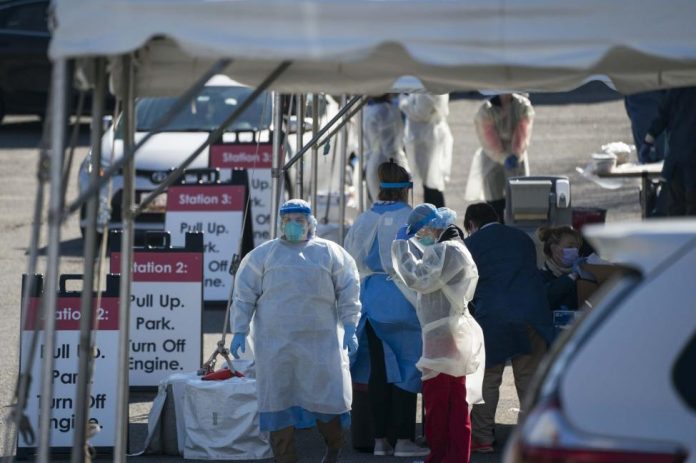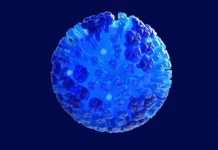
April 4 (UPI) — Researchers may have found a weakness in SARS-CoV2, the virus that causes COVID-19, that provides clues as to how to treat the infection — and possibly develop a vaccine to prevent its spread.
An antibody recovered from a survivor of the early 2000s SARS epidemic revealed a potential vulnerability in the new coronavirus, according to a study published Friday in the journal Science.
SARS, or severe acute respiratory syndrome, like SARS-CoV2, is a type of coronavirus.
The new knowledge “can aid in structure-based design of vaccines and therapeutics against SARS-CoV-2, and these would also protect against other coronaviruses — including those that may emerge in the future,” study co-author Ian Wilson, chair of the Department of Integrative Structural and Computational Biology at Scripps Research, said in a press release.
The first SARS virus, known as SARS-CoV, or SARS-CoV1, first emerged in China in 2002 and infected nearly 9,000 people worldwide, and killed 774, before it was relatively quickly contained.
While COVID-19 has spread farther — through Friday afternoon it had sickened nearly 1.1 million people globally and nearly 59,000 have died — the 2002 SARS outbreak provides a platform for researchers to tackle the new coronavirus, according to Dr. Kevin Harrod, Benjamin Monroe Carraway Endowed Chair and professor of infectious diseases at the University of Alabama-Birmingham.
“We learned a lot from the SARS outbreak in the early 2000s,” Harrod, who worked on the U.S. response, told UPI. He was not part of the Scripps research.
“However, we’ve never seen a coronavirus that was both this contagious and this deadly,” he added.
SARS-CoV, which causes SARS, originated in horseshoe bats and first jumped to humans in China in 2002. That outbreak was largely contained through lockdowns, quarantines and other measures.
SARS-CoV-2, meanwhile, is a closely related coronavirus that first emerged in Wuhan, China.
“It’s not surprising that we’re seeing a 100-year pandemic roughly 100 years after the last major pandemic — the 1918-19 flu pandemic,” Harrod said. “What’s surprising is that it’s been caused by a coronavirus. With this virus, we have no vaccine and, because it’s new, there is no immunity against it, so it’s going to cause more disease.”
The new study is focused on the anti-SARS-CoV antibody CR3022, which was first isolated in 2006 by the pharmaceutical company Crucell Holland B.V. A study published in February in the journal Emerging Microbes and Infections suggested CR3022 cross-reacts against SARS-CoV-2.
Using blood donations from people who have recovered from COVID-19, Wilson’s team used a near-atomic-scale resolution structural mapping method to determine how the antibody binds to SARS-CoV-2. The analysis revealed a nearly identical site on both coronaviruses to which the antibody binds that appears to be functionally important and vulnerable.
The Scripps Research analysis also found that the antibody binding site is relatively remote — not normally accessible to antibodies — from the part of the virus that grabs hold of cell-surface protein receptors to penetrate cells in the lungs. This suggests that, at least for SARS-CoV, CR3002 neutralizes the virus’s ability to infect cells in some indirect way.
“We found that this region is usually hidden inside the virus, and only exposed when that part of the virus changes its structure, as it would in natural infection,” said co-author Dr. Meng Yuan, a research associate at Scripps.
Another key finding is that the antibody binds to similar sites in both coronaviruses — the sites differ by just four amino acids. That high degree of similarity indicates that the site has an important function that would be lost if it mutated significantly, Scripps researchers said.
They note, however, that the antibody binds much less tightly to COVID-19 than it does to SARS, and cannot neutralize SARS-CoV-2 in lab dish tests as it does SARS-CoV. But the findings suggest the binding site is a vulnerability, and that antibodies binding to it more tightly could neutralize the virus.
The findings also indicate there may be other antibodies that effectively neutralize both SARS and COVID-19 — and perhaps do the same with future coronaviruses — the Scripps team said.
“Our ultimate goal here is to obtain structural information on antibodies and their binding sites, and use that to guide SARS-CoV-2 vaccine design, just as our lab has done with influenza and HIV,” said co-author Nicholas Wu, a postdoctoral research associate at Scripps.






